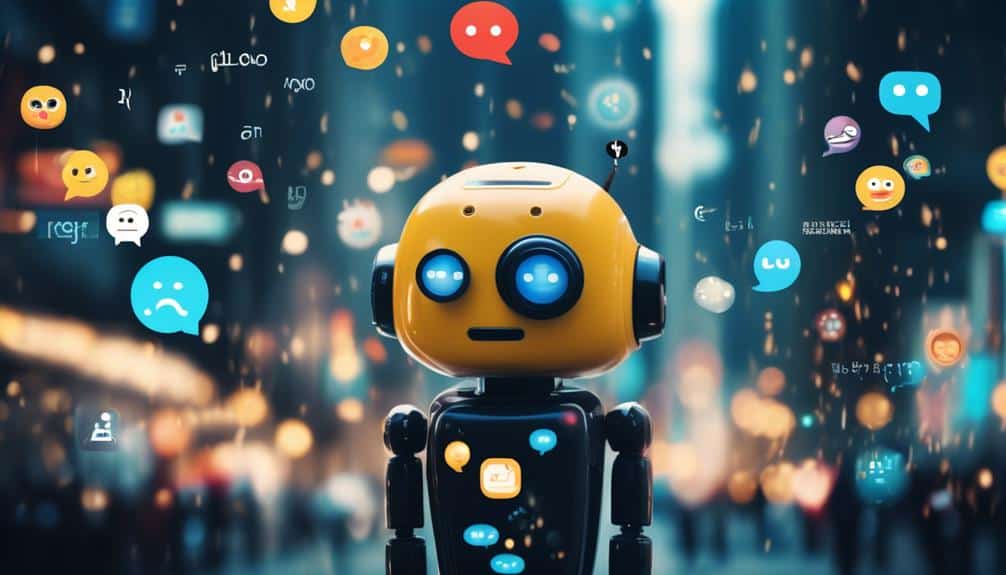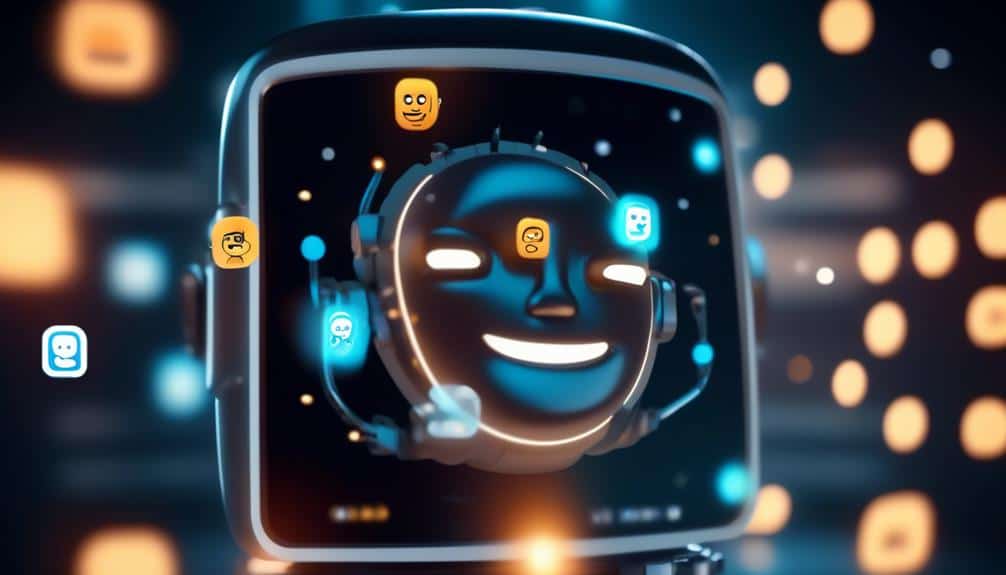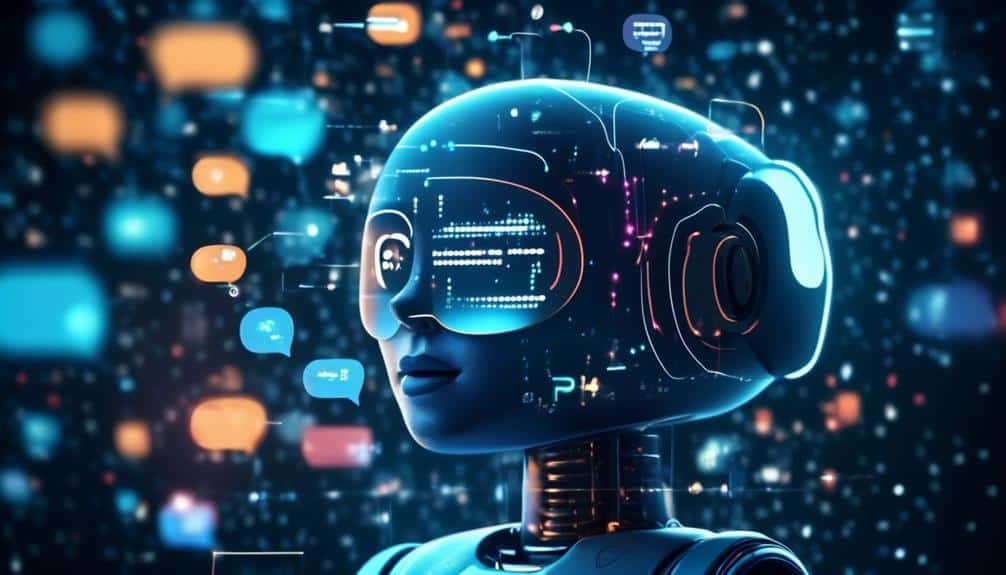AI-Powered Chatbots: Crafting Dynamic Conversations for Enhanced User Experience
You might be thinking that chatbots lack the ability to engage users in meaningful conversations beyond predefined responses. However, with advancements in AI technology, chatbots have evolved to craft dynamic dialogues tailored to individual preferences, offering an enhanced user experience.
By harnessing the power of artificial intelligence, these chatbots can adapt their interactions in real-time, providing personalized and engaging conversations that mimic human-like interactions. The result? A seamless and effective way to connect with users that goes beyond mere functionality, ultimately transforming the user experience landscape.
Key Takeaways
- AI-powered chatbots are evolving to provide more personalized and engaging conversational experiences.
- User intent analysis and data-driven personalization are essential for tailoring interactions to individual users.
- Dynamic content personalization and conversational design strategies enhance user engagement and satisfaction.
- Measuring chatbot performance through feedback analysis, performance metrics tracking, and user satisfaction surveys is crucial for continuous improvement and impact assessment.
Evolution of Chatbot Technology

Explore how chatbot technology has rapidly evolved in recent years, shaping dynamic conversational experiences for users. The historical perspective of chatbot evolution showcases a journey from basic rule-based systems to sophisticated AI-powered bots capable of understanding natural language.
Initially, chatbots were limited in their responses and functionalities, providing predefined answers to specific questions. However, with advancements in artificial intelligence and natural language processing, chatbots now offer personalized interactions, proactive suggestions, and seamless integration with various platforms.
Looking ahead, future trends in chatbot technology point towards even more advanced capabilities. Technological advancements such as machine learning algorithms and neural networks are driving chatbots to become more intuitive and human-like in their interactions. These improvements aim to enhance user experiences by providing quicker, more accurate responses and anticipating user needs.
As chatbot technology continues to evolve, users can expect more dynamic conversational experiences that feel increasingly natural and engaging.
Understanding User Intent
So, you want your chatbot to really get what you mean, right?
User Intent Analysis and Intent Prediction Techniques are the keys to unraveling your users' thoughts and needs.
User Intent Analysis
Understanding user intent is crucial for AI-powered chatbots to deliver personalized and effective conversations that enhance user experience. By analyzing user intent, chatbots can provide more relevant responses based on contextual understanding and conversational context.
Through intent classification, chatbots can anticipate user behavior and tailor their interactions accordingly, creating a smoother and more user-centric experience. This analysis enables chatbots to interpret user queries more accurately, leading to quicker resolutions and increased user satisfaction.
Intent Prediction Techniques
To enhance the effectiveness of AI-powered chatbots, mastering intent prediction techniques is essential for delivering tailored and engaging user experiences. When it comes to understanding user intent, predictive modeling and machine learning algorithms play a crucial role.
Here are four key techniques to consider:
- Natural Language Processing (NLP): Utilize NLP to analyze and interpret user input accurately.
- Contextual Understanding: Enhance chatbot responses by considering the context of the conversation.
- Historical Data Analysis: Leverage past interactions to predict future user intents more effectively.
- Real-time Learning: Implement algorithms that can adapt and improve based on new user interactions instantly.
Personalization Through Data Analysis

Hey there! Ready to take your chatbot game to the next level? Let's talk personalization through data analysis.
Get ready for data-driven customization strategies, tailored user experiences, and dynamic content personalization to enhance your user interactions.
Isn't it exciting to see how leveraging data can transform your chatbot into a personalized, engaging conversational experience?
Data-Driven Customization Strategies
In the realm of AI-powered chatbots, implementing data-driven customization strategies enhances user experiences through personalized interactions tailored to individual preferences and behaviors. When it comes to enhancing user engagement and personalization through data analysis, here are some effective strategies:
- Data-Driven Optimization: Utilize data analysis to constantly refine and improve the chatbot's responses, ensuring a seamless conversational flow.
- Behavior-Based Customization: Tailor responses based on user behavior patterns, making interactions more relevant and engaging.
- Real-Time Personalization: Adjust responses in real-time based on user input, providing a dynamic and personalized experience.
- Predictive Analytics: Use data insights to anticipate user needs and guide conversations proactively, creating a more intuitive chatbot experience.
Tailored User Experiences
How can data analysis revolutionize personalized user experiences in AI-powered chatbots?
By analyzing user data, chatbots can offer customized interactions and personalized responses tailored to individual preferences.
Imagine having a chatbot that remembers your previous conversations, understands your preferences, and anticipates your needs.
This level of personalization is achievable through data analysis, where patterns and trends in user behavior are identified to create a unique and engaging experience for each user.
By utilizing data-driven insights, chatbots can adapt their responses in real-time, providing users with relevant information and solutions.
The future of chatbots lies in delivering tailored user experiences that feel natural, intuitive, and truly personalized.
Dynamic Content Personalization
By harnessing the power of data analysis, AI-powered chatbots can seamlessly tailor dynamic content personalization to enhance user experiences, creating interactions that feel uniquely catered to individual preferences. Here's how this content adaptation boosts user engagement:
- Real-time Data Analysis: Chatbots analyze user input instantly to provide relevant responses.
- Behavioral Pattern Recognition: Recognizing patterns in user behavior allows chatbots to anticipate needs.
- Personalized Recommendations: By understanding user preferences, chatbots offer tailored suggestions.
- Adaptive Conversations: Chatbots adjust their dialogue based on user interactions, ensuring a personalized experience that fosters engagement.
With these strategies, AI chatbots can elevate user engagement through personalized content adaptation, making interactions more meaningful and effective.
Natural Language Processing Capabilities

Unleash the power of natural language processing capabilities in AI-powered chatbots for seamless and dynamic conversations. By harnessing these cutting-edge technologies, chatbots can achieve a deeper contextual understanding of user queries and provide more relevant responses. This advanced form of language processing enables chatbots to interpret user input in a more human-like manner, leading to more engaging interactions.
Natural language processing capabilities in chatbots allow them to analyze not just the words used by the user but also the underlying meaning and intent behind those words. This means that chatbots can respond intelligently to a wide range of user queries, even if they're phrased in different ways or contain spelling or grammatical errors.
With these sophisticated language processing tools at their disposal, AI-powered chatbots can offer users a more personalized and efficient experience. Whether it's answering customer inquiries, providing product recommendations, or assisting with service requests, chatbots equipped with natural language processing capabilities can elevate the overall user experience to new heights. Experience the future of conversational AI with chatbots that truly understand you.
Implementing Conversational Design Strategies
Enhance user engagement and satisfaction by incorporating conversational design strategies into AI-powered chatbots. When implementing conversational design strategies, focus on creating a seamless conversation flow and interactive responses that keep users intrigued and involved.
Here's how you can craft dynamic conversations for an enhanced user experience:
- Personalization: Tailor the chatbot interactions to each user by incorporating personal preferences and past interactions into the conversation flow.
- Empathy: Design the chatbot to understand and respond empathetically to user emotions, creating a more human-like interaction.
- Clear Navigation: Ensure the conversation flow is clear and intuitive, guiding users through the interaction effortlessly.
- Feedback Loop: Implement mechanisms for capturing user feedback within the conversation to continuously improve the chatbot's interactive responses.
Enhancing User Engagement With AI

To elevate user engagement with AI, consider infusing interactive elements that captivate and immerse users in a dynamic digital experience. AI engagement thrives on user interaction that feels personalized and tailored to individual needs. By incorporating features like personalized recommendations, interactive quizzes, or gamified elements, you can enhance the user experience and keep them engaged.
User interaction plays a crucial role in creating a connection between the user and the AI system. Encouraging users to provide feedback, ask questions, or engage in meaningful conversations can significantly boost AI engagement. Utilizing chatbots that can hold natural, flowing conversations and provide valuable information in real-time can also enhance user engagement with AI.
Innovative features such as voice commands, augmented reality experiences, or predictive suggestions based on user behavior can further elevate the level of engagement users have with AI. By continuously refining and adapting these interactive elements based on user feedback and behavior patterns, you can create a dynamic and engaging AI experience that keeps users coming back for more.
Measuring Chatbot Performance and Impact
When evaluating the performance and impact of your chatbot, focus on key metrics that provide actionable insights into user interactions and overall effectiveness. To ensure your chatbot is meeting user expectations and delivering value, consider the following:
- Chatbot feedback analysis: Dive deep into user feedback to understand what's working well and where improvements are needed. Analyzing feedback can uncover common pain points and areas for enhancement.
- Performance metrics tracking: Monitor key performance indicators such as response time, resolution rate, and conversation completion rate. Tracking these metrics can help you optimize your chatbot's performance over time.
- User satisfaction surveys: Implement surveys to gather direct feedback on user satisfaction levels. Understanding how satisfied users are with the chatbot experience can guide improvements and enhancements.
- Impact assessment techniques: Use techniques like A/B testing to measure the impact of changes or new features on user interactions. This data-driven approach can help you make informed decisions to enhance your chatbot's effectiveness.
Frequently Asked Questions
How Does the Use of Ai-Powered Chatbots Impact Customer Satisfaction and Retention Rates in Comparison to Traditional Customer Service Methods?
Using AI-powered chatbots for customer engagement can boost satisfaction and retention rates compared to traditional methods. They provide a competitive advantage by offering instant support and personalized interactions, enhancing user experience and loyalty.
What Are the Potential Ethical Implications of Using Ai-Powered Chatbots, Particularly in Terms of Privacy and Data Security?
When using AI-powered chatbots, you might want to consider privacy concerns and data protection. It's essential to ensure that personal information is secure and used responsibly to maintain user trust and safeguard sensitive data.
How Do Ai-Powered Chatbots Handle Complex User Queries That Require a High Level of Contextual Understanding?
When handling complex user queries, AI-powered chatbots leverage contextual understanding to provide dynamic responses, ensuring high user engagement. By analyzing input data and recognizing patterns, chatbots can tailor interactions to meet users' specific needs effectively.
What Are Some of the Key Challenges in Implementing and Maintaining Ai-Powered Chatbots in a Business Setting?
Implementing challenges for AI-powered chatbots often revolve around integration complexities and data privacy concerns. Maintenance hurdles include ensuring continuous learning and adaptation to user needs. Overcoming these obstacles demands strategic planning and agile solutions.
Can Ai-Powered Chatbots Effectively Mimic Human Empathy and Emotional Intelligence in Customer Interactions?
Sure, AI-powered chatbots can develop emotional intelligence to mimic human empathy in interactions. By crafting human-like responses, they enhance user experience. Incorporating empathy algorithms, chatbots can offer personalized, empathetic responses, improving customer interactions significantly.
Conclusion
Crafting dynamic conversations with AI-powered chatbots is key to enhancing user experience. By understanding user intent, personalizing interactions, and utilizing natural language processing, chatbots can engage users in meaningful ways.
Implementing conversational design strategies and continuously measuring performance are essential for success. With AI technology constantly evolving, the possibilities for creating engaging and personalized user experiences through chatbots are endless.
Embrace the power of AI chatbots to revolutionize your customer interactions and drive business growth.








